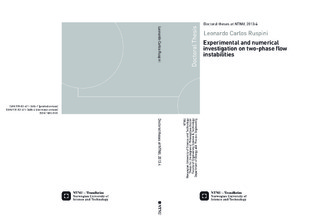| dc.contributor.author | Ruspini, Leonardo Carlos | nb_NO |
| dc.date.accessioned | 2014-12-19T11:50:02Z | |
| dc.date.available | 2014-12-19T11:50:02Z | |
| dc.date.created | 2013-02-13 | nb_NO |
| dc.date.issued | 2013 | nb_NO |
| dc.identifier | 605261 | nb_NO |
| dc.identifier.isbn | 978-82-471-3404-7 (printed version) | nb_NO |
| dc.identifier.isbn | 978-82-471-3405-4 (electronic version) | nb_NO |
| dc.identifier.uri | http://hdl.handle.net/11250/235013 | |
| dc.description.abstract | Two-phase flow instabilities are experimentally and numerically studied within this thesis. In particular, the phenomena called Ledinegg instability, density wave oscillations and pressure drop oscillations are investigated.
The most important investigations regarding the occurrence of two-phase flow instabilities are reviewed. An extensive description of the main contributions in the experimental and analytical research is presented. In addition, a critical discussion and recommendations for future investigations are presented.
A numerical framework using a hp-adaptive method is developed in order to solve the conservation equations modelling general thermo-hydraulic systems. A natural convection problem is analysed numerically in order to test the numerical solver. Moreover, the description of an adaptive strategy to solve thermo-hydraulic problems is presented.
In the second part of this dissertation, a homogeneous model is used to study Ledinegg, density wave and pressure drop oscillations phenomena numerically. The dynamic characteristics of the Ledinegg (flow excursion) phenomenon are analysed through the simulation of several transient examples. In addition, density wave instabilities in boiling and condensing systems are investigated. The effects of several parameters, such as the fluid inertia and compressibility volumes, on the stability limits of Ledinegg and density wave instabilities are studied, showing a strong influence of these parameters. Moreover, the phenomenon called pressure drop oscillations is numerically investigated. A discussion of the physical representation of several models is presented with reference to the obtained numerical results. Finally, the influence of different parameters on these phenomena is analysed.
In the last part, an experimental investigation of these phenomena is presented. The designing methodology used for the construction of the experimental facility is described. Several simulations and a non-dimensional similitude analysis are used to support the design, regarding the occurrence of two-phase flow instabilities. Some experimental results are presented in order to validate the current design. A full characterisation of the pressure drop losses in the facility is presented. Both, distributed and local pressure drop losses are investigated and the experimental results are compared with the main correlations used in the literature for the analysis of pressure drop in two-phase flow systems. Finally, pressure drop and density wave oscillations are studied experimentally, with main focus on the interaction of these two oscillation modes. In addition, the influence of compressibility volumes on the stability limits for the density wave phenomenon is analysed. | nb_NO |
| dc.language | eng | nb_NO |
| dc.publisher | Norges teknisk-naturvitenskapelige universitet, Fakultet for ingeniørvitenskap og teknologi, Institutt for energi- og prosessteknikk | nb_NO |
| dc.relation.ispartofseries | Doktoravhandlinger ved NTNU, 1503-8181; 2013:4 | nb_NO |
| dc.title | Experimental and numerical investigation on two-phase flow instabilities | nb_NO |
| dc.type | Doctoral thesis | nb_NO |
| dc.contributor.department | Norges teknisk-naturvitenskapelige universitet, Fakultet for ingeniørvitenskap og teknologi, Institutt for energi- og prosessteknikk | nb_NO |
| dc.description.degree | PhD i energi- og prosessteknikk | nb_NO |
| dc.description.degree | PhD in Energy and Process Engineering | en_GB |
